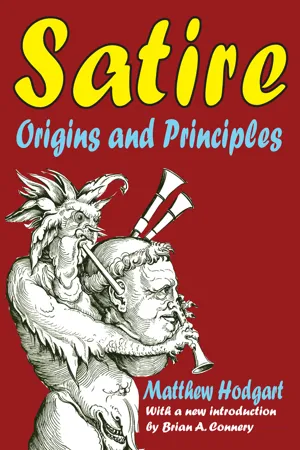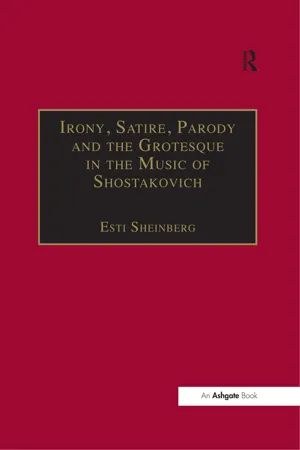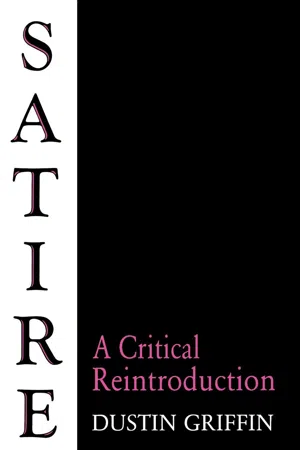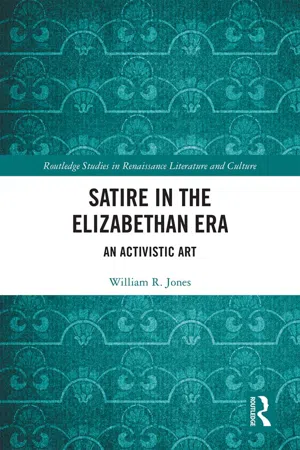Literature
Satirical Poetry
Satirical poetry is a form of literature that uses humor, irony, and exaggeration to criticize and ridicule human vices, foolishness, and societal issues. It often employs wit and sarcasm to provoke change or bring attention to social or political injustices. Through clever wordplay and mockery, satirical poetry aims to entertain and enlighten while challenging the status quo.
Written by Perlego with AI-assistance
4 Key excerpts on "Satirical Poetry"
- eBook - ePub
Satire
Origins and Principles
- Matthew Hodgart(Author)
- 2017(Publication Date)
- Routledge(Publisher)
2 The topics of satire: politicsThe most pressing of the problems that face us when we close the book or leave the theatre are ultimately political ones; and so politics is the pre-eminent topic of satire. 'Public affairs vex no man' said Samuel Johnson, but he could not have been more wrong: to some degree public affairs vex every man, if he pays taxes, does military service or even objects to the way his neighbour is behaving. There is no escape from politics where more than a dozen people are living together.There is an essential connection between satire and politics in the widest sense: satire is not only the commonest form of political literature, but, insofar as it tries to influence public behaviour, it is the most political part of all literature. Both are felt to be rather discreditable: the word 'politician' has an unfavourable sense, and satirists keep apologising for their wicked tongues. But both are necessary, since all social and legal systems are in need of continuous reform, and politics is the only means of achieving reform; while only satire can release powerful enough acids to break down the attitudes of mind which hinder reform. Most of the great satirists have in fact been deeply interested in politics, and most have been against the established government of their countries. Those who have supported the government by writing satire against its critics, as Dryden did in Absalom and Achitophel, are usually attacking the alternative kind of government which they can conceive of the critics setting up: thus Dryden, who had lived through the Commonwealth, had a very clear idea of what Whig opposition could lead to, as well as a deep fear of civil war.The enemies of satire are tyranny and provincialism, which often go together. Tyrants dislike any form of criticism, because they never know where it will lead to; and in provincial life free criticism is felt to be subversive of good order and decency. Satire did not flourish under Stalin, nor will it ever flourish in Little Rock or Alice Springs. Political satire needs a measure of freedom, the background of large cities and some sophistication: political sophistication (both the satirist and his public must understand some of the processes of politics) and aesthetic sophistication (the satirist must be able to contemplate the political scene with humour and detachment as well as with passion, or he will produce only crude polemic). In the great days of fifth-century Athens, these conditions obtained to perfection. Aristophanes commented with unparalleled freedom on the affairs of the day, combining the primitive traditions of satire, the lampoon and the saturnalian travesty, with an extraordinary inventiveness. He represented real citizens like Cleon and Socrates on the stage, and he created wonderful realms of fantasy in which the social and political order is crazily inverted. His earliest extant play The Acharnians was produced in 425 BC when he was barely twenty. It is a powerful plea for an armistice in the bitter war against Sparta, and a violent attack on the warparty led by the demagogue Cleon. Significantly, it begins with a picture of Athenian democracy in action: Dicaeopolis, the anti-war hero, comes to the assembly saying that he has 'decided to shout at, to interrupt and to satirise (loidorein ) every orator who speaks about anything else but peace'. Aristophanic satire is here shown as closely linked with free speech and democratic decision, a link which is maintained throughout his work. Dicaeopolis has no success in the assembly, so he decides to make a separate peace with Sparta, as a private individual - he contracts out. He then earns the hatred of the Chorus of Acharnians, a rural clan who were famous for being warlike and anti-Spartan; but he wins over first half and then the whole of the Chorus by a series of comic arguments to show that the causes of the war are ridiculous. Now won over, the Chorus speak the parabasis - eBook - ePub
Irony, Satire, Parody and the Grotesque in the Music of Shostakovich
A Theory of Musical Incongruities
- Esti Sheinberg(Author)
- 2017(Publication Date)
- Routledge(Publisher)
The vertical axis is the axis of criticism, with progression from Reality to Fiction, and it is designed to include the characteristic which distinguishes satirical literature from other types of literature on the one hand, and from non-literature on the other. Satire is the meeting point of criticism and humor in a literary work. This meeting point is already expressed in the concept of ridicule, but ridicule does not always equal satire. Finally, satire is also situated somewhere between literature proper (Fiction), where the literary text does not necessarily enter into referential relationship with the world, and non-literature (Reality), where, as in everyday speech, there is a clear referential relationship. An ideal satire should be situated closer to, rather than farther from the intersection of the two axes (Petro, 1982: 128) As in the case of irony, most writers on satire use various and sometimes overlapping terms to describe its specific ramifications: burlesque, irony, the grotesque, parody and even tragedy are constantly interchanged with satire. Within all this variety, however, there is one general agreement: satire relies on a given set of norms, and uses ridicule, often in an aggressive manner, to indicate actual instances of failure to match their standards (Pollard, 1970: 3; Nichols, 1971: 14, 18; Fletcher, 1987: ix). The norms of satire are characteristically (though not necessarily!) related to ethical and social values (Pollard, 1970: 7). Thus satire bears a historical, reality-related character, and is therefore never totally fictional (Petro, 1982: 128). The simplest case of satire would then be a phenomenon that, being incongruous with an accepted norm, is ridiculed - eBook - ePub
Satire
A Critical Reintroduction
- Dustin Griffin(Author)
- 2021(Publication Date)
- The University Press of Kentucky(Publisher)
In the late fourth century the grammarian Diomedes defined satire as “a verse composition . . . defamatory and composed to carp at human vices” (maledicum et ad carpenda hominum vitia). 14 Furthermore, he has in mind only the tradition of Roman verse satire as written by Lucilius, Horace, and Persius (whom he names), omitting the Varronian or Menippean tradition altogether. Though he acknowledges satire’s complex etymology, from satyrs or the lanx satura or the lex satura, 15 Diomedes defines the form in wholly moral terms. He says nothing of wit, humor, playfulness, exaggeration or fantasy or paradox, iconoclasm or the carnival spirit. It is ultimately writers like Diomedes, reflecting what G.L. Hendrickson called the “moral obsession of literary criticism in later antiquity,” 16 who lead more or less directly to the emphasis on satire’s moral function that dominates satiric theory from the Renaissance into the mid-twentieth century. Elizabethan Theory Sixteenth-century English writers on satire inherited several different traditions: a broad medieval tradition of “complaint” 17 that ranged in English alone from Langland and Chaucer to Barclay and Skelton; Lucianic dialogues, once prized for their sophistication but by the Reformation increasingly associated with scoffing atheism; a line of epistolary satire in Italy from Vingiguerra to Alamanni and Ariosto, based primarily on Horatian models. Oddly enough, with all this wealth of living tradition and despite the recovery of classical Roman formal satire, the dominant theory of satire among Renaissance writers was based on their notion of Greek satyr plays (of which they knew almost nothing), a theory that could account for very little of the satire with which they were familiar - eBook - ePub
Satire in the Elizabethan Era
An Activistic Art
- William Jones(Author)
- 2017(Publication Date)
- Routledge(Publisher)
2 For literary scholars, the end result of such dissimulation is a history of eminently useful formalist, Historicist, Reader Response, and many other approaches to satiric literature that are nonetheless plagued with manifold exceptions, uncomfortable generalities, and interpretive dead ends.Indeed, the chasm between theoretical approaches to satire and the practice of satire remains as broad and deep today as it has ever been, particularly with regard to satiric historicity, or the nature and degree of contact a particular form of satire has with the various material conditions of its historical moment. On the academic side of the expanse, scholars of satire have long acknowledged the need to account for the presence of historical forces in the interpretation of satiric literature, but more often than not, they have subsumed satire’s overt historicity beneath the genre’s more legitimizing formal features. The ephemeral nature of satire’s unapologetic interest in topicality, of representing “particular events,” and as a consequence, becoming “inescapably tied to those events but at an uneasy tension with them” (Knight 50), is certainly valuable to scholars. That engagement provides a tantalizing window into, or more precisely, a distorted mirror that reflects (a popular metaphor for the satirist’s art) contemporary realities, those “things that men do, their desires, their fears, their rage, their pleasures, their joys, their fumbling around” as Juvenal writes (85–86).3 However, as fascinating as topical referentiality is, it should come as no surprise that literary exegetes have tended to prefer the “universal” in satire over “dated” representations because an excessive focus on topicality in satiric literature threatens to anchor the work in question too firmly, too materially, in a precise temporal moment whose political and cultural specifics are largely unrecoverable, not to mention risking the devaluation of the aesthetic complexity of the work. It is certainly important for literary scholars to admit, for example, that John Dryden’s Absalom and Achitophel represent, at one level, the Duke of Monmouth and the Earl of Shaftesbury, or that Jonathan Swift’s King of Lilliput is, again, at one level, a parody of King George I. However, in early-twentieth-century Historicist criticism, such analogical parallels only served to diminish the role of history in the interpretation of satire by presenting such historical components as little more than an intriguing Roman-à-clef
Index pages curate the most relevant extracts from our library of academic textbooks. They’ve been created using an in-house natural language model (NLM), each adding context and meaning to key research topics.
Explore more topic indexes
Explore more topic indexes
1 of 6
Explore more topic indexes
1 of 4



